JavaScript遍历实现DFS算法和BFS算法
itwangyang 人气:0DFS(Depth first search)
Depth first search 称作「深度优先遍历」
下面结合具体例子来理解。如图所示,在一个九宫格图中,绿色位置代表起始位置,红色代表终点位置,灰色区域和宫格图的边界代表此路不通,请从起始位置按照每次只能移动一格的方法移动到终点位置。
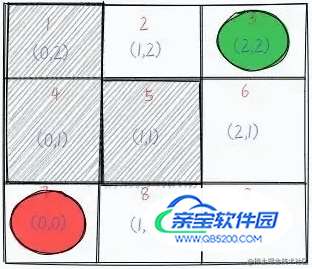
我们用 DFS 的方法去解这道题,由图可知,我们可以走上下左右四个方向,我们不妨先约定 “左>上>右>下” 的顺序走,即,如果左边可以走,我们先走左边。然后「递归」下去,没达到终点,我们再原路返回,等又返回到这个位置时,左边已经走过了,那么我们就走上面,按照这样的顺序走。并且我们把走过的路(方向)作标记表示“不能走回头路”。
按照约定,我们先从起点首先向左走到位置 2,这时发现左边不能走了,这时我们就考虑往上走,发现也不能走,同理,下边也不能走。右边刚才已经走过了也不能走,这时候无路可走了,代表这条路不能通往终点,所以现在「无路可走」的时候,沿着原路返回,直到回到了还有未走过的路的路口,尝试继续走没有走过的路径。
于是我们只有回到最初的位置 1,然后判断左边刚才已经走过了并且证实这个方向行不通,那就不必走了,上和右也是不通,所以我们走下边。于是走到了 6 的位置,此时还是按照约定“左>上>右>下” 的顺序走,左边和右边依然不通,上边刚才已经走过了,所以得继续往下走。
继续往下那就是位置 9 了,到了这个路口我们继续按照约定“左>上>右>下” 的顺序,先往左发现可以走,那么就继续走到位置 8,到了位置 8 还是按照刚才的思路继续往左,发现还可以走,并且最终到达终点位置 7。
综上所述,这个过程就是「深度优先遍历」。
DFS 的重点在于状态回溯,因此我们作个思路总结:
- 深度优先遍历 只要前面有可以走的路,就会一直向前走,直到无路可走才会回头;
- 「无路可走」有两种情况:① 遇到了墙;② 遇到了已经走过的路;
- 在「无路可走」的时候,沿着原路返回,直到回到了还有未走过的路的路口,尝试继续走没有走过的路径;
- 有一些路径没有走到,这是因为找到了出口,程序就停止了;
- 「深度优先遍历」也叫「深度优先搜索」,遍历是行为的描述,搜索是目的(用途);
- 遍历不是很深奥的事情,把所有可能的情况都看一遍,才能说「找到了目标元素」或者「没找到目标元素」。遍历也称为穷举,穷举的思想在人类看来虽然很不起眼,但借助计算机强大的计算能力,穷举可以帮助我们解决很多专业领域知识不能解决的问题。
使用 DFS 来解答刚才题目的代码如下:
//我们以红点位置为坐标{0,0},绿色位置坐标为{2,2}
//目标的坐标位置
let target = {
x: 0,
y: 0
};
//绿色起点的坐标位置
let currentLocation = {
x: 2,
y: 2
};
let used = []; //用来标记地图上哪些点是走过的
let reached = false; //是否能到达目标位置
// 表示灰色区域的格子
const illegalLocation = [
{ x: 0, y: 2 }, //序号1的坐标
{ x: 0, y: 1 }, //序号4的坐标
{ x: 1, y: 1 } //序号5的坐标
];
function isLegalLocation({ x, y }, illegalLocation) {
let flag = true;
//位置不能在地图坐标之外
if (x < 0 || x > 2 || y < 0 || y > 2) {
return (flag = false);
}
//不能走的路径
for (const { x: locX, y: locY } of illegalLocation) {
if (x === locX && y === locY) {
flag = false;
}
}
return flag;
}
//向左移动
function toLeft({ x, y }) {
return { x: x - 1, y };
}
//向上移动
function toTop({ x, y }) {
return { x, y: y + 1 };
}
//向右移动
function toRight({ x, y }) {
return { x: x + 1, y };
}
//向下移动
function toBottom({ x, y }) {
return { x, y: y - 1 };
}
function dfs(target, location, illegalLocation, used) {
// 如果当前位置与目标坐标相同表示可以抵达
if (Object.entries(target).toString() === Object.entries(location).toString()) {
console.log('reached', location);
return (reached = true);
}
let current = location;
const newIllegalLocation = illegalLocation.concat(used);
//假设按照“左>上>右>下”的顺序走
if (isLegalLocation(toLeft(location), newIllegalLocation)) {
current = toLeft(location);
} else if (isLegalLocation(toTop(location), newIllegalLocation)) {
current = toTop(location);
} else if (isLegalLocation(toRight(location), newIllegalLocation)) {
current = toRight(location);
} else if (isLegalLocation(toBottom(location), newIllegalLocation)) {
current = toBottom(location);
} else {
//走不通了就直接返回
return false
}
used.push(current); //将刚才走过的格子标记为已走过
return dfs(target, current, illegalLocation, used); //递归下去
}
dfs(target, currentLocation, illegalLocation, used);BFS(Breadth first search)
Breadth first search 称作「广度优先遍历」
BFS 较之 DFS 之不同在于,BFS 旨在面临一个路口时,把所有的岔路口都记下来,然后选择其中一个进入,然后将它的分路情况记录下来,然后再返回来进入另外一个岔路,并重复这样的操作,用图形来表示则是这样的:
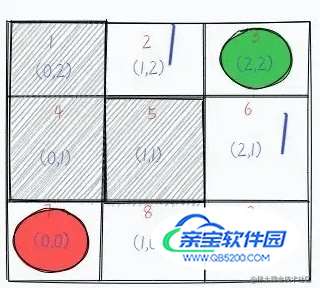
从绿色起点出发,记录所有的岔路口,并标记为走一步可以到达的。然后选择其中一个方向走进去,我们走绿色左边(序号为 2)的那个格子,然后将这个路口可走的方向记录下来并标记为 2,意味走两步可以到达的地方。
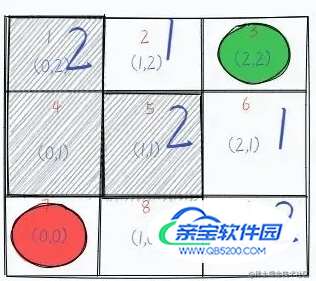
接下来,我们回到起点下面 1 的方块上(序号为 6),并将它能走的方向也记录下来,同样标记为 2,因为也是走两步便可到达的地方。这样走一步以及走两步可以到达的地方都搜索完毕了,后续同理,我们可以把走三步的格子给标记出来。
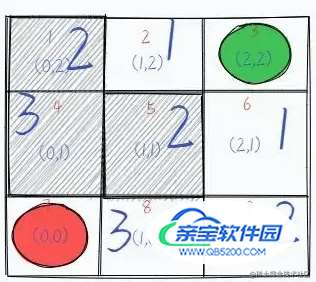
再之后是第四步。我们便成功寻找到了路径,并且把所有可行的路径都求出来了。
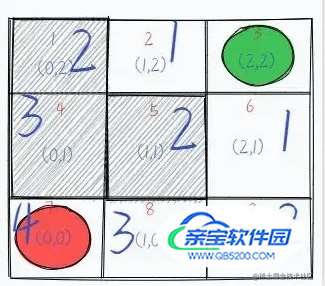
注意:格子序号分别为 1、4、5 的地方是灰色区域表示此路不通。
使用 BFS 来解答刚才题目的代码如下:
//我们以红点位置为坐标{0,0},绿色位置坐标为{2,2}
//目标的坐标位置
let target = {
x: 0,
y: 0
};
//绿色起点的坐标位置
let currentLocation = {
x: 2,
y: 2
};
// 表示灰色区域的格子
const illegalLocation = [
{ x: 0, y: 2 }, //序号1的坐标
{ x: 0, y: 1 }, //序号4的坐标
{ x: 1, y: 1 } //序号5的坐标
];
function isLegalLocation({ x, y }, illegalLocation) {
let flag = true;
//位置不能在地图坐标之外
if (x < 0 || x > 2 || y < 0 || y > 2) {
return (flag = false);
}
//不能走的路径
for (const { x: locX, y: locY } of illegalLocation) {
if (x === locX && y === locY) {
flag = false;
}
}
return flag;
}
//向左移动
function toLeft({ x, y }) {
return { x: x - 1, y };
}
//向上移动
function toTop({ x, y }) {
return { x, y: y + 1 };
}
//向右移动
function toRight({ x, y }) {
return { x: x + 1, y };
}
//向下移动
function toBottom({ x, y }) {
return { x, y: y - 1 };
}
function bfs(target, location, illegalLocation) {
let reached = false; //是否能到达目标位置
let stack = [];
let searched = new Set(); //已经走过的格子
stack.push(location);
while (stack.length) {
let temp = stack.pop();
const newIllegalLocation = illegalLocation.concat([...searched]);
//假设按照“左>上>右>下”的顺序走
if (isLegalLocation(toLeft(temp), newIllegalLocation)) {
temp = toLeft(temp);
} else if (isLegalLocation(toTop(temp), newIllegalLocation)) {
temp = toTop(temp);
} else if (isLegalLocation(toRight(temp), newIllegalLocation)) {
temp = toRight(temp);
} else if (isLegalLocation(toBottom(temp), newIllegalLocation)) {
temp = toBottom(temp);
} else {
//没有通路就直接返回
return false
}
searched.add(temp);
stack.push(temp);
for (const { x: locX, y: locY } of searched) {
if (target.x === locX && target.y === locY) {
//如果当前位置与目标坐标相同表示可以抵达
reached = true;
console.log('reached: ', reached);
stack = [];
break;
}
}
}
return reached;
}
bfs(target, currentLocation, illegalLocation);「广度优先遍历」的思想在生活中随处可见:
- 如果我们要找一个律师,我们会先在朋友中查找,如果没有找到,继续在朋友的朋友中查找,直到找到为止。
- 把一块石头投入平静的水面,激起的一层一层波纹就呈现「广度优先遍历」的特点。
总结
- 「一条路走到底,不撞南墙不回头」是对 DFS 的最直观描述。因此 DFS 可以借助「递归」实现。
- BFS 呈现出「一层一层向外扩张」的特点,先看到的节点先遍历,后看到的节点后遍历,因此 BFS 可以借助「队列」实现。(遍历到一个节点时,如果这个节点有左(右)孩子节点,依次将它们加入队列。)
- DFS 适合目标明确的寻找,而 BFS 适合大范围的寻找。
加载全部内容